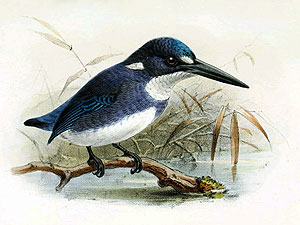Guadalcanal Little Kingfisher (Ceyx pusillus ssp. aolae)
The Guadalcanal Little Kingfisher is one of the nine subspecies of the Little Kingfisher (Ceyx pusillaTemminck), a species that occurs from Australia to parts of melanesia; it is known only from the type specimen that was collected on the island of Guadalcanal, eastern Solomon Islands.
The single known specimen is very similar to Richard’s Little Kingfisher (Ceyx pusillus ssp. richardsi Tristram) (see depiction) from the central Solomon Islands, it differs from that subspecies by its incomplete pectoral band and by its white, blue-tipped undertail coverts. [1]
The Guadalcanal Little Kingfisher is often thought to be extinct, this, however, is not entirely certain.
*********************
References:
[1] C. Hilary Fry; Kathie Fry: Kingfishers, Bee-eaters, & Rollers. Helm 1992
*********************

Depiction from: ‘H. B. Tristram: Notes on a collection of birds from the Solomon Islands, with descriptions of new species. The Ibis 133-146. 1882’
(not in copyright)
*********************
edited: 01.11.2020
